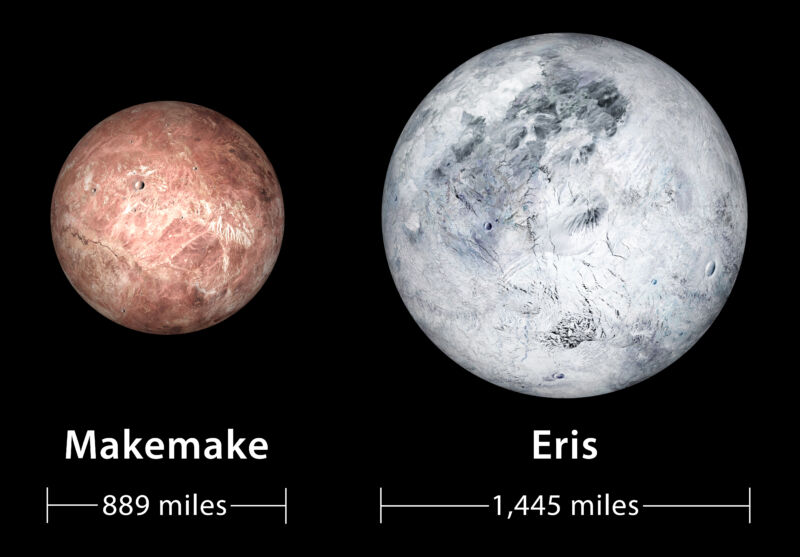
Active geology—and the large-scale chemistry it can drive—requires significant amounts of heat. Dwarf planets near the far edges of the Solar System, like Pluto and other Kuiper belt objects, formed from frigid, icy materials and have generally never transited close enough to the sun to warm up considerably. Any heat left over from their formation was likely long since lost to space.
Yet Pluto turned out to be a world rich in geological features, some of which implied ongoing resurfacing of the dwarf planet’s surface. Last week, researchers reported that the same might be true for other dwarf planets in the Kuiper Belt. Indications come thanks to the capabilities of the Webb telescope, which was able to resolve differences in the hydrogen isotopes found on the chemicals that populate the surface of Eris and Makemake.
Cold and distant
Kuiper Belt objects are natives of the distant Solar System, forming far enough from the warmth of the Sun that many materials that are gasses in the inner planets—things like nitrogen, methane, and carbon dioxide—are solid ices. Many of these bodies formed far enough from the gravitational influence of the eight major planets that they have never made a trip into the warmer inner Solar System. In addition, because there was much less material that far from the Sun, most of the bodies are quite small.
While they would have started off hot due to the process by which they formed, their small size means a large surface-to-volume ratio, allowing internal heat to radiate out to space relatively quickly. Since then, any heat has come from rare collision events or the decay of radioactive isotopes.
Yet New Horizons’ visit to Pluto made clear that it doesn’t take much heat to drive active geology, although seasonal changes in sunlight are likely to account for some of its features. Sunlight is less likely to be an influence for worlds like Makemake, which orbits at a distance one and a half times Pluto’s closest approach to the Sun. Eris, which is nearly as large as Pluto, orbits at over twice Pluto’s closest approach.
Sending a mission to either of these planets would take decades, and none are in development at the moment, so we can’t know what their surfaces look like. But that doesn’t mean we know nothing about them. And the James Webb Space Telescope has added to what we know considerably.
The Webb was used to image sunlight reflected off these objects, obtaining its infrared spectrum—the amount of light reflected at different wavelengths. The spectrum is influenced by the chemical composition of the dwarf planets’ surfaces. Certain chemicals can absorb specific wavelengths of infrared light, ensuring they don’t get reflected. By noting where the spectrum dips, it’s possible to figure out which chemicals are present.
Some of that work has already been done. But Webb is able to image parts of the spectrum that were inaccessible earlier, and its instruments are even able to identify different isotopes of the atoms composing each chemical. For example, some molecules of methane (CH4) will, at random, have one of their hydrogen atoms swapped out for its heavier isotope, deuterium, forming CH3D. These isotopes can potentially act as tracers, telling us things about where the chemicals originally came from.

